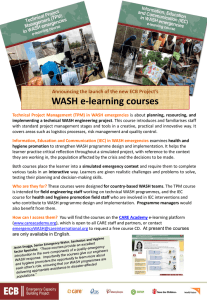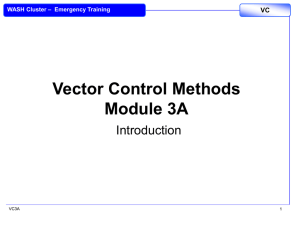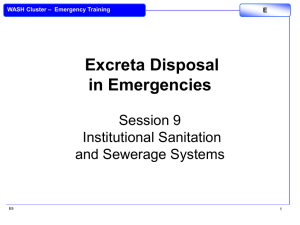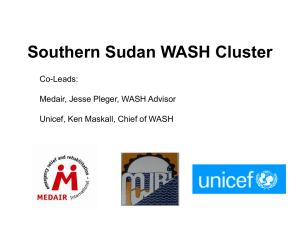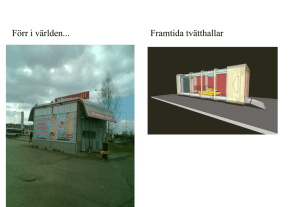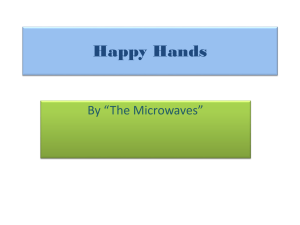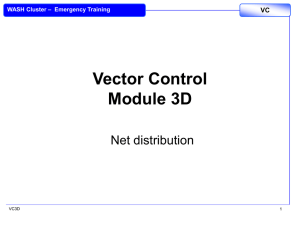VC2B_PP_Mosquito borne disease
advertisement
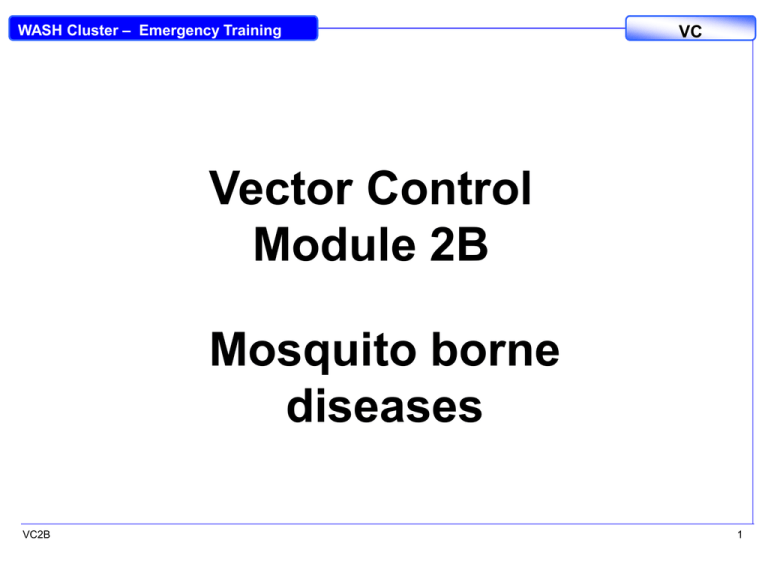
WASH Cluster – Emergency Training VC Vector Control Module 2B Mosquito borne diseases VC2B 1 WASH Cluster – Emergency Training VC Behaviour of mosquitoes Genus Breeding site Disease and distribution Anopeline mosquito Biting period : NIGHT Non polluted water: Edges of rivers, swamps, tanks, rice fields, saltwater without wave action, Malaria : Tropical and sub-tropical Filariasis : Asia and Africa Aedes mosquito Biting period : DAY Small water containers: Cans, jars, gutters Yellow fever : Africa and Americas Dengue : Africa and Americas, Asia Filariasis : Pacific Culex mosquito Biting period : NIGHT Any dirty water: Waste water ditches, latrines, septic pits, Filariasis : Most tropical areas Encephalitis virus: worldwide VC2B 2 WASH Cluster – Emergency Training VC Mosquito Life Cycle VC2B 3 WASH Cluster – Emergency Training VC Lymphatic Filariasis • Transmission by mosquitoes – Anophelenes and Culicines • Filarial worms, Mainly Wuchereria bancrofti, – Also Brugia malayi or B. timori VC2B 4 WASH Cluster – Emergency Training VC Lymphatic Filariasis Endemic Areas Endemic in 83 countries VC2B Guerrant et al 2006, 5 Tropical Infectious Diseases 2nd Ed. WASH Cluster – Emergency Training VC2B VC 6 WASH Cluster – Emergency Training VC Clinical Disease • Hydrocoele • Elephantiasis • Tropical Pulmonary Eosinophilia VC2B 7 WASH Cluster – Emergency Training VC Chichungunya • 'Chikungunya' 'that which bends up' Swahili • 1st documented in 1952 to 1953 in Africa • Alphavirus of family Togaviridae • Primary vectors : Aedes albopictus or aegypti. • 2005 to 2006 - 266,000 cases = 35.0% of the population in Reunion, Madagascar, Mauritius and Seychelles. • 2006 –2007 Outbreaks in India, Sri Lanka & Italy VC2B 8 WASH Cluster – Emergency Training VC Chikungunya Global Distribution VC2B 9 WASH Cluster – Emergency Training VC Outbreaks have increased in scale and frequency in recent years. Distribution follows dengue as it can be transmitted same vectors. VC2B 10 WASH Cluster – Emergency Training VC Insecticide Treated Nets (ITN) Also help to reduce fleas and mites in the bed clothing and mattress VC2B 11 WASH Cluster – Emergency Training VC Environmental Control • The elimination of mosquito breeding sites. • In most circumstances, difficult because of lack of staff, the extent of the breeding sites and cost. • Some breeding sites may also be the only available water. • Malaria mosquitoes can fly several km. • Localised (household) grass cutting and bush cleaning not useful for malaria control. VC2B 12 WASH Cluster – Emergency Training VC Time of biting: Number caught (no.) and Number positive for sporozoites (+) 1800-2200h Species An. gambiae 2200-0200h 0200-0600h Source Tanganyika (Gilles, 1957) no. + 248 9 743 20 606 8 no. + 5900 295 13000 1040 10850 2061 Burkina Faso (Robert 1991) An. gambiae no. 91 1269 1831 Sierra Leone (Bockarie 1996) An . gambiae no. + 23 2 189 14 211 9 Tanzania (Maxwell 1997) An. funestus no. + 31 0 232 7 86 2 An. gambiae /An. funestus VC2B “ 13 WASH Cluster – Emergency Training VC Mosquito prefer pregnant women VC2B 14 WASH Cluster – Emergency Training VC Issue for Control #1 • Different insect vectors may peak in different seasons. The malaria vector may be present during the dry season when other mosquito populations are low. It is important to use LLITN throughout the year if you want to control malaria. VC2B 15 WASH Cluster – Emergency Training VC Longevity (daily survivorship) VC2B 16 WASH Cluster – Emergency Training VC Issue for Control #2 • Mosquitoes don’t live very long – most will die before they can transmit malaria. A mosquito will rest on the wall after it feeds. Therefore Indoor residual spraying (IRS) works It kills the mosquito sometime within the incubation period Spraying your own house, but not the others in the community will not protect your family from malaria. VC2B 17 WASH Cluster – Emergency Training VC Issue for Control #3 • At 25º it takes 12 days before a mosquito can transmit malaria – most will die before then. Below 19º malaria can not be transmitted. • Malaria falls off in winter because of the cooler temperature, but can happen before the rains as long as there is ground water • IRS works by killing the mosquito sometime within the incubation period VC2B 18 WASH Cluster – Emergency Training VC VBD Control Myths 1. 2. 3. 4. 5. All mosquitoes are the same Cutting grass and maize is useful Filling in puddles around house is useful Clearing garbage is useful for malaria control Wearing long sleeve shirts and pants protects 6. Spraying individual houses protects the family VC2B 19 WASH Cluster – Emergency Training VC VBD Control Facts • Sleeping under an LL ITN every night provides good protection against malaria, some filariasis and Lieshmaniasis • IRS also protects equally well against malaria if >85% of houses in a community are sprayed. It may also be effective against mosquito borne Rift valley fever • Larval control works well for dengue fever and to a lesser extend also malaria (i.e. temporary floods etc) but all breeding sites within the flight range of the vector need to be eliminated VC2B 20

